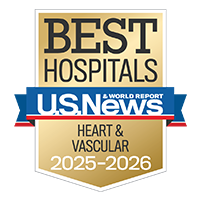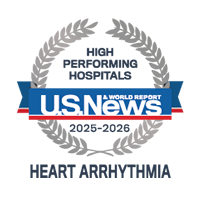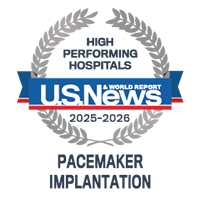Heart Arrhythmia

Overview
What are heart arrhythmias?
A heart arrhythmia is a condition in which there's an irregular or abnormal heartbeat pattern. The heart may beat too quickly, too slowly, or irregularly. A heartbeat change isn't always cause for concern. It's normal for your heart rate to go up during exercise and slow down while you sleep. However, a persistently irregular heartbeat can be an arrhythmia.
Heart arrhythmias range from harmless to life-threatening, depending on the type of irregularity and which part of the heart is involved. Treatments seek to regulate or normalize the heartbeat, which may be achieved through lifestyle changes, medications or procedures.
Our approach to heart arrhythmias
UCSF uses the latest technologies to diagnose and treat heart arrhythmias. For years, addressing abnormal heart rhythms mainly involved medication or, in severe cases, open-heart surgery. Through our Cardiac Electrophysiology and Arrhythmia Service, patients with arrhythmias now have access to a range of cutting-edge therapies. Cardiac electrophysiology – a subspecialty of cardiology focused on the heart's electrical activity – is a rapidly growing field in which researchers are developing new treatments and cures for arrhythmias. Our treatments include radiofrequency catheter ablation, which was developed by UCSF cardiology researchers and is now used by medical institutions nationwide. It's a minimally invasive procedure that destroys the heart tissue triggering the arrhythmia.
Awards & recognition
-

Among the top hospitals in the nation
-

One of the nation's best for heart & vascular care
-

Rated high-performing hospital for heart arrhythmia care
-

Rated high-performing hospital for pacemaker implantation
Causes of heart arrhythmias
An arrhythmia occurs when the electrical signals that tell your heart to pump don't work properly. Several problems can disrupt these electrical signals. The nerve cells that produce the signals may malfunction. Or the signals may not be traveling normally through the heart muscle. Or one part of the heart may begin producing signals that disrupt its normal rhythm.Risk factors for heart arrhythmias
Risk factors for arrhythmias are similar to those for other heart conditions. They include:
- Age. Like all heart conditions, arrhythmias are more common in older people. This is often due to scarring on the heart or to other chronic conditions, such as high blood pressure, heart failure or hyperthyroidism.
- Family history. Some arrhythmias run in families. If you have a close family member diagnosed with an arrhythmia, your risk is higher.
- Smoking. Tobacco use increases the risk of developing a heart arrhythmia.
- Excessive alcohol use. Men who have more than two drinks a day and women who have more than one raise their risk of heart arrhythmias.
- Medications. Certain prescription meds are linked to arrhythmias, including some for high blood pressure, some antidepressants, antipsychotic drugs and some oral antibiotics. The same is true of some over-the-counter allergy and cold medications.
- Certain health conditions. Cardiomyopathy (diseased heart muscle), heart attack, sleep apnea and kidney disease are among the conditions that can increase the risk of heart arrhythmias.
- Surgery. Arrhythmias can develop in the days and weeks after surgeries involving the heart, lungs or throat.
Types of heart arrhythmia
The main types include:
- Atrial fibrillation. Also called A-fib, this condition is when uncoordinated electrical impulses cause erratic and unusually fast heartbeats.
- Bradycardia. The heart beats at a slower-than-normal rate.
- Heart block. This occurs when your heart's electrical signals can’t pass normally from the upper chambers to the lower ones. It can slow your heartbeat and, in the most severe cases (called complete heart block), cause your heart to stop.
- Supraventricular tachycardia. The heart suddenly starts beating rapidly, then abruptly slows down.
- Ventricular fibrillation (VF). The heart's ventricles (lower chambers) flutter instead of contracting, so the heart can't pump blood properly. This serious condition can lead to loss of consciousness and sudden death.
Symptoms of heart arrhythmias
Some cardiac arrhythmias don't produce any symptoms, while others may give rise to the following:
- Heart palpitations
- Dizziness
- Fainting
- Shortness of breath
- Chest pain
- Fast or slow heartbeat
Ventricular fibrillation (VF) is the most severe type of arrhythmia. Gasping, fainting, loss of consciousness, and chest pressure or pain may be signs of VF. This condition can lead to cardiac arrest and death if it isn't treated right away. If you have any of these symptoms, call 911 immediately.
If you have any arrhythmia symptoms that don't go away quickly or that return, you should see your doctor. They'll likely refer you to a cardiologist or an electrophysiologist specializing in heart rhythm disorders. If you have a close family member who died suddenly from a heart-related condition, be sure to have a thorough medical evaluation as well.
Diagnosis of heart arrhythmias
To diagnose an arrhythmia, your doctor will review your medical history and give you a physical exam. They'll also likely order tests to measure and track your heart rate. Some tests can be done during an appointment in the clinic, while some require wearing a heart monitoring device to collect information over a period of time.
Tests to diagnose heart arrhythmias
The main test used to diagnose an arrhythmia is an electrocardiogram (ECG), a simple, painless procedure that records your heart’s electrical activity. An ECG can show how fast your heart beats, its rhythms, and the strength and timing of the electrical impulses passing through each part of your heart.
In addition to an ECG, your doctor may recommend the following tests:
- Cardiac event monitor. These small devices record your heart rate and rhythm over a period of time. They're used to monitor symptoms that don't happen regularly. Types of monitors include looping memory monitors, symptom event monitors, patch recorders and implantable loop recorders (placed under the skin of your chest).
- Echocardiogram. This test uses sound waves (ultrasound) to produce pictures of your heart. These images are more detailed than standard X-rays.
- Holter monitor. This portable ECG is worn for 24 to 48 hours to continuously record how your heart functions during your daily activities.
Additional tests for heart arrhythmias
In some cases, the arrhythmia is happening so occasionally that it isn't captured by one of the tests mentioned above. If those tests don't detect an irregular heartbeat, your doctor may suggest one or all of the following:
- Exercise stress test. Performed while you're connected to an ECG, this test tracks your heart when it's working hard and beating fast. You exercise on a stationary bike or treadmill while your heart's performance is monitored.
- Electrophysiology (EP) procedure. This study, which is done in the hospital, assesses your heart's electrical function, helping doctors to diagnose heart arrhythmias.
- Tilt table test. If you've been fainting or had repeated episodes of dizziness or lightheadedness, your doctor might recommend this test. You lie down on a table that's then tilted to put you in a standing position. Your heart rate and blood pressure are monitored to see how your body responds to the change in position.
Treatment of heart arrhythmias
How an arrhythmia is treated depends on the type. When an underlying condition, such as heart failure, is causing the irregular heartbeat, it also needs to be treated. Common treatments include:
- Cardioversion. Either medication or an electrical shock to the heart is used to reset its beating, thereby restoring a normal rhythm.
- Catheter ablation. This minimally invasive technique uses radiofrequency waves to destroy the heart tissue that’s causing the arrhythmia.
- Pacemaker. This small device is implanted into your chest to control your heartbeat.
- Implantable cardioverter defibrillator (ICD). A device about the size of a deck of cards is implanted in your chest. It delivers an electric jolt to your heart when it beats irregularly.
- Left atrial appendage closure. Done to reduce the risk of strokes from atrial fibrillation, this minimally invasive procedure involves closing off a small appendage on the heart's left upper chamber, where stroke-causing clots tend to form.














